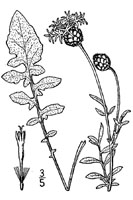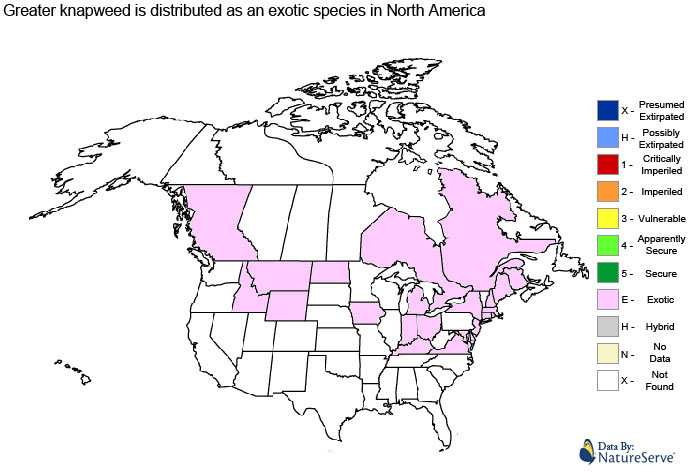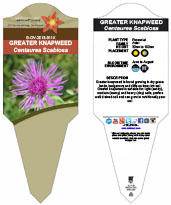

| Plant Name | Greater Knapweed | |
| Scientific Name | Centaurea Scabiosa | |
| Family | Aster | |
| Plant Type | Biannual | |
| Start of Blooming Season | June | |
| End of Blooming Season | August |

| Soil Conditions | |
| Soil Moisture | |
| Sunlight | |
| Notes: |

Greater Knapweed is a perennial with highly branched, wiry-stemmed, hairy stalks which can grow up to 90cm tall. The leaves are a pale grayish-green. They are covered in fine short hairs. First year plants produce a basal rosette, alternate, up to 150 mm long, deeply divided into lobes. The plant produces a stem in its second year of growth. Stem leaves are progressively less lobed, getting smaller toward the top. The stem is erect or ascending, slender, hairy and branching, and can grow up to one meter tall. During the summer greater knapweed plants have multiple violet to lavender ray-less flowers. Greater Knapweed is very hardy and easily overpowers other nearby plant species with a tap root that sucks up water faster than the root systems of its neighbours and releasing a toxin from its roots that stunts the growth of nearby plants of other species. Greater Knapweed also produces a large number of seeds which ripen from August to October and can easily be spread. Its seed is an achene about a quarter of an inch long, with a small bristly pappus at the tip which makes the wind its primary means of dispersal. The flowers are hermaphrodite (have both male and female organs) and are pollinated by Bees, flies, lepidoptera, and by self.The plant is self-fertile.


The following health hazards should be noted when handling or choosing a location to plant greater knapweed:
 |
SHARP HAZARD Greater Knapweed has thorns on the flowers.
|
 |
INVASION ALERT Greater knapweed is a highly invasive species and is banned by many jurisdictions for deliberate cultivation. Check with local conservation authorities before attempting to cultivate this species. |

 |
-Click here- or on the thumbnail image to see an artist rendering, from The United States Department of Agriculture, of greater knapweed. (This image will open in a new browser tab) |

Greater Knapweed can be translated into the following select languages:
| Arabic | Bulgarian | вид червена метличина | Chinese (Sim) | 矢车菊 | |
| Croatian | različak | Czech | plevel | Danish | |
| Dutch | Esperanto | Estonian | Kaunokki | ||
| Finnish | kaunokki | French | centaurée | German | Flockenblume |
| Greek | Hebrew | Hungarian | búzavirág | ||
| Italian | fiordaliso | Japanese | ヤグルマギク | Korean | 수레 국화 속 |
| Low Saxon | Lithuanian | Shui | Norwegian | ||
| Persian | قنطوریون اسود | Polish | Portuguese | centáurea-maior | |
| Romanian | Russian | василек | Slovak | burinu | |
| Spanish | Swedish | Tagalog | |||
| Turkish | mor top çiçekli bitki | Ukrainian | волошка | Vietnamese | cây xa cúc |

| The information provided in this conservation assessment has been provided by the Natureserve Database in conjuction with various federal, provincial, state, county, district, regional, and municipal governments as well as public and private conservation authorities. Information in this section is accurate from the last time this article was updated. | |
 |
Greater Knapweed has no conservation status as it is considered an exotic and or invasive species in North America. |

 |

 |
The MIROFOSS database offers free printable garden tags for personal and non-profit use. These tags can be used to properly identify plant samples in a garden. Click on the tags shown on the the screen or -click here- to download a full size jpeg image for a greater knapweed identification tag; which can be printed on paper or used with a plastic laser printer. |
 |
What's this? What can I do with it? |

| Description / Application | Frost, R. A., & Launchbaugh, K. L. (2003). "Prescription Grazing for Rangeland weed Management: A New Look at an Old Tool.". Rangelands. |
| Description | DiTomasso, J.M. (2000). "Invasive weeds in rangelands: Species, impacts, and management". Weed Management: 255–265. |
| Folklore | Somers, Paul (2008). A guide to invasive plants in Massachusetts. Massachusetts division of fisheries and wildlife. p. 39 |
| Biology | Roger L. Sheley, James S. Jacobs and Michael F. Carpinelli (April–Jne 1998). "Distribution, Biology, and Management of Diffuse Knapweed (Centaurea diffusa) and spotted knapweed (Centaurea maculosa)". Weed Technology: 353–362. |
| Biology | John R. Lacey, Clayton B. Marlow and John R. Lane (1989). "Influence of spotted knapweed (centaurea maculosa) on surface runoff and sediment yield". weed technology: 627–631. |
| Biology | Blair, Amy; Nissen, Scott j.; Hufbauer, Ruth A.; Brunk, Galen R. (September 2006). "A Lack of Evidence for an Ecological Role of the Putative Allelochemical (±)-Catechin in spotted knapweed". Journal of Chemical Ecology. |
| Image Rendering | USDA-NRCS PLANTS Database / USDA NRCS. Wetland flora: Field office illustrated guide to plant species. USDA Natural Resources Conservation Service. |
| Environment | National Audubon Society. Field Guide To Wildflowers (Eastern Region): Alfred A. Knopf. pp 415-420 ISBN 0-375-40232-2 |
| Physical Identification | National Audubon Society. Field Guide To Wildflowers (Eastern Region): Alfred A. Knopf. pp 415-420 ISBN 0-375-40232-2 |
| April 02, 2015 | The last time this page was updated |
| ©2021 MIROFOSS™ Foundation | |
 |